Tribology and Anti-Ablation Properties of SiC-VN-MoS2/Ta Composite Coatings on Carbon/Carbon Composites from 25 to 800 °C
Abstract
:1. Introduction
2. Experiment
2.1. Preparations of the Composite Coatings
2.2. Frictional Experiments at Room Temperature and 800 °C
2.3. Weight Loss at 800 °C
2.4. Bearing Capacity and Crack Generation Analysis
3. Results and Discussions
3.1. Tribological Properties at Different Temperature
3.2. Anti-Ablation Properties at 800 °C
3.3. Bearing Capacity and Crack Generation
4. Conclusions
- (1)
- The CoF of C/C composites decreased by 156% when the SiC–VN–MoS2/Ta were coatings prepared at 800 °C. The oxides and compounds of V, Mo and Ta have self-lubricating performances at high temperatures.
- (2)
- The weight loss of C/C composites at 800 °C decreased by 25,300% under the protection of SiC–VN–MoS2/Ta coatings. Oxygen is prevented from contacting C/C composites.
- (3)
- The deformation of the C/C substrate under the coating protection looks like a quadrangular star. Without coating protection, cracks appear on the surface of the C/C composites. The cack of the C/C composites is easily generated without the coating protection.
Author Contributions
Funding
Institutional Review Board Statement
Informed Consent Statement
Data Availability Statement
Conflicts of Interest
References
- Chen, F.; Li, Z.; Zou, L.-F.; Ma, W.-J.; Li, J.-W.; Chen, Z.; Niu, Z.-B.; Liu, P.-F.; Xiao, P. Tribological behavior and mechanism of h-BN modified copper metal matrix composites paired with C/C–SiC. Tribol. Int. 2020, 153, 106561. [Google Scholar] [CrossRef]
- Sun, H.; Fan, S.; Wang, L.; Ma, X.; Deng, J.; Cheng, L.; Zhang, L. Microstructure and tribological properties of PIP-SiC modified C/C–SiC brake materials. Ceram. Int. 2021, 47, 15568–15579. [Google Scholar] [CrossRef]
- Ou-Yang, X.; Li, Z.; Xiao, P.; Chen, G.Y.; Li, J.W.; Liu, P.F. Effects of the high-temperature treatment of C/C composites on their tribological properties. New Carbon Mater. 2019, 34, 472–481. [Google Scholar] [CrossRef]
- Wang, P.; Wei, F.C.; Zhao, Z.W.; Guo, Y.G.; Du, S.M.; Hao, Z.H. Effect of heat treatment temperature on mechanical and tribological properties of copper impregnated carbon/carbon composite. Tribol. Int. 2021, 164, 107209. [Google Scholar] [CrossRef]
- Kumar, P.; Sricastava, V.K. A review on wear and friction performance of carbon–carbon composites at high temperature. Int. J. Appl. Ceram. Technol. 2016, 13, 702–710. [Google Scholar] [CrossRef]
- Fun, Q.G.; Jing, J.Y.; Li, H.J.; Jin, X.X.; Zhuang, L.; Li, L. Design of an inlaid interface structure to improve the oxidation protective ability of SiC–MoSi2–ZrB2 coating for C/C composites. Ceram. Int. 2016, 42, 4212–4220. [Google Scholar]
- Qian, T.X.; Zeng, Y.; Xiong, X.; Ye, Z.M.; Lun, H.L.; Hu, J.R.; Wang, Y.L.; Zhang, Z.W.; Yan, C.C. Corrosion behavior of Y2O3-doped mullite-ZrSiO4 coatings applied on C/C–SiC composites in the presence of moisture at temperatures of 1373–1773 K. Ceram. Int. 2020, 46, 12861–12869. [Google Scholar] [CrossRef]
- Li, T.; Zhang, Y.L.; Zhang, J.; Fu, Y.Q.; Li, J. Improved antioxidative and mechanical properties of SiC coated C/C composites via a SiO2-SiC reticulated layer. J. Eur. Ceram. Soc. 2021, 41, 6151–6159. [Google Scholar] [CrossRef]
- Zhuang, L.; Fu, Q.G.; Ma, W.H.; Zhang, Y.Y.; Yan, N.N.; Song, Q.; Zhang, Q. Oxidation protection of C/C compo-sites: Coating development with thermally stabile SiC@PyC nanowires and an interlocking TaB2-SiC structure. Corros. Sci. 2019, 148, 307–316. [Google Scholar] [CrossRef]
- Zhou, W.; Xiao, P.; Luo, W.; Li, Y. Microstructural evolution of SiC coating on C/C composites exposed to 1500 °C in ambient air. Ceram. Int. 2018, 45, 854–860. [Google Scholar] [CrossRef]
- Liu, F.; Li, H.; Gu, S.Y.; Yao, X.Y.; Fu, Q.G. Microstructure and oxidation property of CrSi2-ZrSi2-Y2O3/SiC coating prepared on C/C composites by supersonic atmosphere plasma spraying. Surf. Coat. Technol. 2019, 374, 966–974. [Google Scholar] [CrossRef]
- Huo, C.X.; Guo, L.J.; Zhou, L.; Liu, B.; Wang, C.C.; Zhang, Y.L.; Wang, H.Q. Effect of Al2O3 addition on the ablation behavior of SiC-ZrC coated C/C composites. J. Alloys Compd. 2018, 752, 489–504. [Google Scholar] [CrossRef]
- Liu, F.H.; Yi, M.Z.; Ran, L.P.; Ge, Y.C.; Peng, K. Influence of preparation method on microstructure and tribo-logical behavior of C/C-BN composites. Ceram. Int. 2021, 47, 12879–12896. [Google Scholar] [CrossRef]
- Dong, Z.J.; Liu, S.X.; Li, X.K.; Westwood, A.; Yuan, G.M.; Cui, Z.W.; Cong, Y. Influence of infiltration temperature on the microstructure and oxidation behavior of SiC–ZrC ceramic coating on C/C composites prepared by re-active melt infiltration. Ceram. Int. 2014, 41, 797–811. [Google Scholar] [CrossRef] [Green Version]
- Zhang, J.P.; Fu, Q.G.; Li, H.J.; Sun, G.D.; Sun, C.; Nan, X.Y.; Li, S.F.; Liu, L. Ablation behavior of Y2SiO5/SiC coating for C/C composites under oxyacetylene torch. Corros. Sci. 2014, 87, 472–478. [Google Scholar] [CrossRef]
- Venkata, S.B.; Siva, R.I.; Ganguly, G.S.; Rao, G.S.; Sahoo, K.L. Quantitative studies on wear behavior of Al–(Al2O3–SiC–C) composite prepared with in situ ceramic composite developed from colliery waste. Proc. Inst. Mech. Eng. Part J J. Eng. Tribol. 2015, 299, 823–834. [Google Scholar] [CrossRef]
- Kasar, A.K.; Menezes, P.L. Friction and wear behavior of alumina composites with in-situ formation of aluminum borate and boron nitride. Materials 2020, 13, 4502. [Google Scholar] [CrossRef]
- Leszczyńska-Madej, B.; Madej, M.; Garbiec, D. Tribological properties of spark plasma sintered Al-SiC composites. Materials 2020, 13, 4969. [Google Scholar] [CrossRef]
- Cao, H.; Liu, F.; Li, H.; Qi, F.; Ouyang, X.; Zhao, N.; Liao, B. High temperature tribological performance and thermal conductivity of thick Ti/Ti-DLC multilayer coatings with the application potential for Al alloy pistons. Diam. Relat. Mater. 2021, 117, 108466. [Google Scholar] [CrossRef]
- Kaczorowski, W.; Świątek, H.; Łuczak, K.; Głuszek, M.; Cłapa, M. Impact of plasma pre-treatment on the tribological properties of DLC coatings on PDMS substrates. Materials 2021, 14, 433. [Google Scholar] [CrossRef] [PubMed]
- Lee, K.Y.; Wei, R. Tribological characteristics of DLC-coated alumina at high temperatures. J. Tribol. 2006, 128, 711–717. [Google Scholar] [CrossRef]
- Fan, X.M.; Yin, X.W.; He, S.S.; Zhang, L.T.; Cheng, L.F. Friction and wear behaviors of C/C-SiC composites con-taining Ti3SiC2. Wear 2012, 188–195, 274–275. [Google Scholar]
- Kong, L.Q.; Bi, Q.L.; Zhu, S.Y.; Liu, W.M. Self-lubricating behavior of ZrO2 (Y2O3)-Mo-CaF2-Graphite Composite. Adv. Mater. Res. 2013, 815, 584–587. [Google Scholar] [CrossRef]
- Cao, J.; Yin, Z.; Li, H.; Gao, G.; Zhang, X. Tribological and mechanical properties of Ti2AlC coating at room temperature and 800 °C. Ceram. Int. 2018, 44, 1046–1051. [Google Scholar] [CrossRef]
- Zhang, R.; Ding, Q.; Zhang, S.; Li, Y.; Niu, Q.; Yang, L.; Ye, J.; Hu, L. The effects of ultrasonication on the microstructure, gelling and tribological properties of 12-HSA soft-nanocomposite with LaF3 nanoparticles. Colloids Surf. A Physicochem. Eng. Asp. 2019, 586, 124247. [Google Scholar] [CrossRef]
- Zhao, Z.; Ma, Y.; Wan, H.; Ye, Y.; Chen, L.; Zhou, H.; Chen, J. Preparation and tribological behaviors of polyamide-imide/polytetrafluoroethylene lubricating coatings reinforced by in-situ synthesized CeO2 nanoparticles. Polym. Test. 2021, 96, 107100. [Google Scholar] [CrossRef]
- Mehar, S.; Sapate, S.; Vashishtha, N.; Bagde, P. Effect of Y2O3 addition on tribological properties of plasma sprayed Al2O3-13% TiO2 coating. Ceram. Int. 2020, 46, 11799–11810. [Google Scholar] [CrossRef]
- Feng, T.; Li, H.J.; Fu, Q.Q.; Shi, X.H.; Hu, M.H.; Liu, L. Erosion resistance of Mo–Si–Cr coating-modified C/C composites in a wind tunnel at 1873 K. J. Alloys Comp. 2015, 622, 1049–1054. [Google Scholar] [CrossRef]
- Reddy, A.C. Evaluation of thermal expansion of Al/B4C metal matrix composites. In Proceedings of the NCMMP (National Conference on Materials and Manufacturing Processes), Hyderabad, India, 22–25 February 2002; pp. 196–200. [Google Scholar]
- Feng, T.; Li, H.J.; Shi, X.H.; Li, X.Y.; Yao, X.Y. Sealing role of B2O3 in MoSi2–CrSi2–Si/B-modified SiC coating for C/C composites. Corros. Sci. 2012, 60, 4–9. [Google Scholar] [CrossRef]
- Yuan, J.; Lv, Z.; Lu, Q.; Cheng, Y.; Chen, X.; Cai, L. First-principles study of the phonon vibrational spectra and thermal properties of hexagonal MoS2. Solid State Sci. 2015, 40, 1–6. [Google Scholar] [CrossRef]
- Liu, L.; Li, H.; Hao, K.; Shi, X.; Li, K.; Ni, C. Effect of SiC Location on the ablation of C/C–SiC Composites in two heat fluxes. J. Mater. Sci. Technol. 2015, 31, 345–354. [Google Scholar] [CrossRef]
- Buchanan, F.; Little, J. Particulate-containing glass sealants for carbon-carbon composites. Carbon 1995, 33, 491–497. [Google Scholar] [CrossRef]
- Semenov, V.; Shuster, S.L.; Chertovskikh, C.; Jeng, Y.R.; Huang, S.J.; Dao, Y.Z.; Hwang, S.J. Tribology of composite materials on the basis of magnesium alloy with powder filler of SiC. Tribol. Ind. 2007, 29, 37–40. [Google Scholar]
- Li, F.; Zhu, S.; Cheng, J.; Qiao, Z.; Yang, J. Tribological properties of Mo and CaF2 added SiC matrix composites at elevated temperatures. Tribol. Int. 2017, 111, 46–51. [Google Scholar] [CrossRef]
- Qiu, Y.; Zhang, S.; Li, B.; Wang, Y.; Lee, J.-W.; Li, F.; Zhao, D. Improvement of tribological performance of CrN coating via multilayering with VN. Surf. Coat. Technol. 2013, 231, 357–363. [Google Scholar] [CrossRef]
- Fateh, N.; Fontalvo, G.A.; Gassner, G.; Mitterer, C. Influence of high-temperature oxide formation on the tribological behaviour of TiN and VN coatings. Wear 2007, 262, 1152–1158. [Google Scholar] [CrossRef]
- Aouadi, S.; Singh, D.; Stone, D.; Polychronopoulou, K.; Nahif, F.; Rebholz, C.; Muratore, C.; Voevodin, A. Adaptive VN/Ag nanocomposite coatings with lubricious behavior from 25 to 1000 °C. Acta Mater. 2010, 58, 5326–5331. [Google Scholar] [CrossRef]
- Qiu, Y.; Zhang, S.; Lee, J.-W.; Li, B.; Wang, Y.; Zhao, D. Self-lubricating CrAlN/VN multilayer coatings at room temperature. Appl. Surf. Sci. 2013, 279, 189–196. [Google Scholar] [CrossRef]
- Zhen, J.M.; Li, F.; Zhu, S.Y.; Ma, J.Q.; Qiao, Z.H.; Liu, W.M.; Yang, J. Friction and wear behavior of nickel-alloy-based high temperature self-lubricating composites against Si3N4 and Inconel 718. Tribol. Int. 2014, 75, 1–9. [Google Scholar] [CrossRef]
- Brown, J.R.; Forster, N.H. Numerical Investigation of the Effect of carbon-carbon composite cages on high-speed bearing operating temperatures. Tribol. Trans. 2002, 45, 411–417. [Google Scholar] [CrossRef]
- Bai, Y.; Xing, J.; He, Y.; Liu, Z.; Huang, Q.; Ma, S.; Gao, Y. Tribological behavior of in-situ (Cr, Mo)/Fe3Al-20 wt.%Al2O3 composites at elevated temperatures. Proc. Inst. Mech. Eng. Part J J. Eng. Tribol. 2014, 228, 904–912. [Google Scholar] [CrossRef]
- Hu, C.-X.; Li, H.-J.; Zhang, S.-Y.; Song, Y.-S. Numerical simulation on thermal expansion coefficient of 3D braided C/C composites. Rare Met. 2013, 33, 99–106. [Google Scholar] [CrossRef]
- Poorteman, M.; Descamps, P.; Cambier, F.; Plisnier, M.; Canonne, V.; Descamps, J. Silicon nitride/silicon carbide nanocomposite obtained by nitridation of SiC: Fabrication and high temperature mechanical properties. J. Eur. Ceram. Soc. 2003, 23, 2361–2366. [Google Scholar] [CrossRef]
- Marcinowski, J.; Różycki, Z.; Sakharov, V. Numerical simulations of destructive tests of cast iron columns strengthened with a CFRP coating. Materials 2020, 13, 4608. [Google Scholar] [CrossRef] [PubMed]
- Wang, K.; Zhang, F.; Bordia, R.K. FEM Modeling of in-plane stress distribution in thick brittle coatings/films on ductile substrates subjected to tensile stress to determine interfacial strength. Materials 2018, 11, 497. [Google Scholar] [CrossRef] [Green Version]
- Deng, J.L.; Hu, K.Y.; Lu, B.F.; Zheng, B.H.; Fan, S.W.; Zhang, L.T.; Cheng, L.F. Influence of B4C on oxidation resistance of PSN/borosilicate glass-B4C field-based repair coating of C/C aircraft brake materials at 700–900 °C. Ceram. Int. 2019, 45, 20860–20872. [Google Scholar] [CrossRef]
- Sun, G.D.; Li, H.J.; Fu, Q.G.; Zhang, Q. Effect of B2O3/SiO2 mass ratio on oxidation resistant property of phosphate coating for C/C composites. Mater. Res. Innov. 2014, 18, 4715–4718. [Google Scholar] [CrossRef]

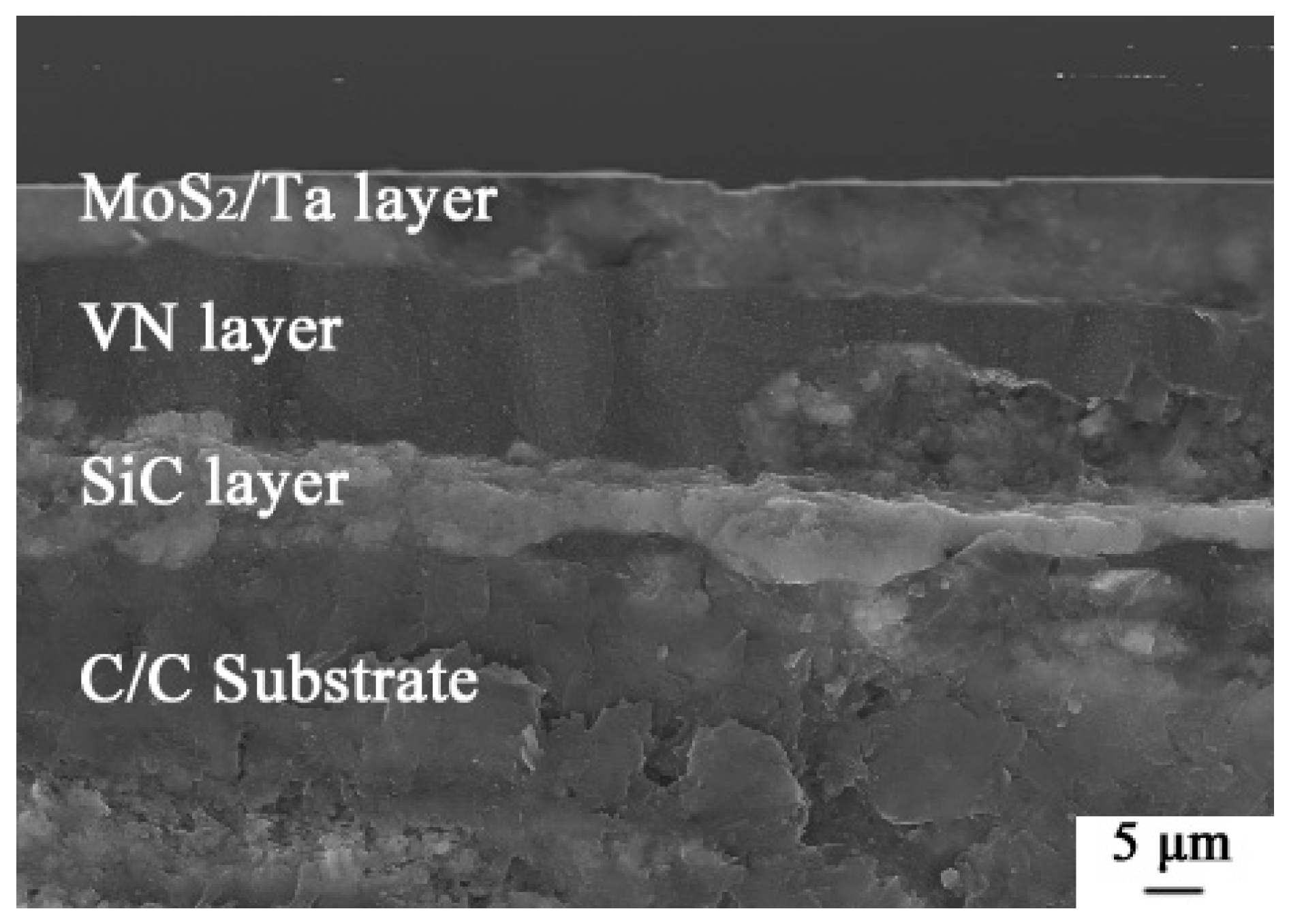
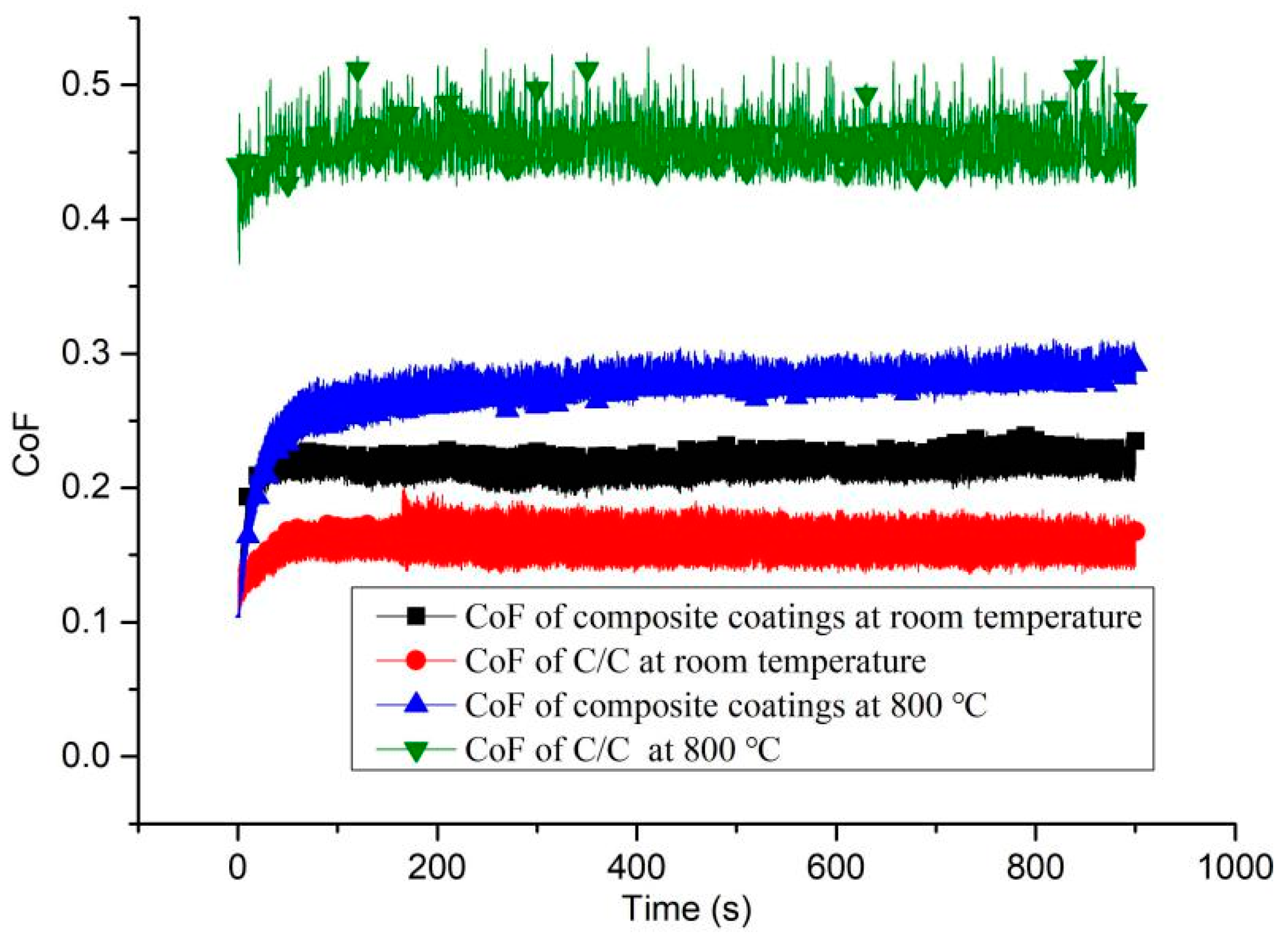
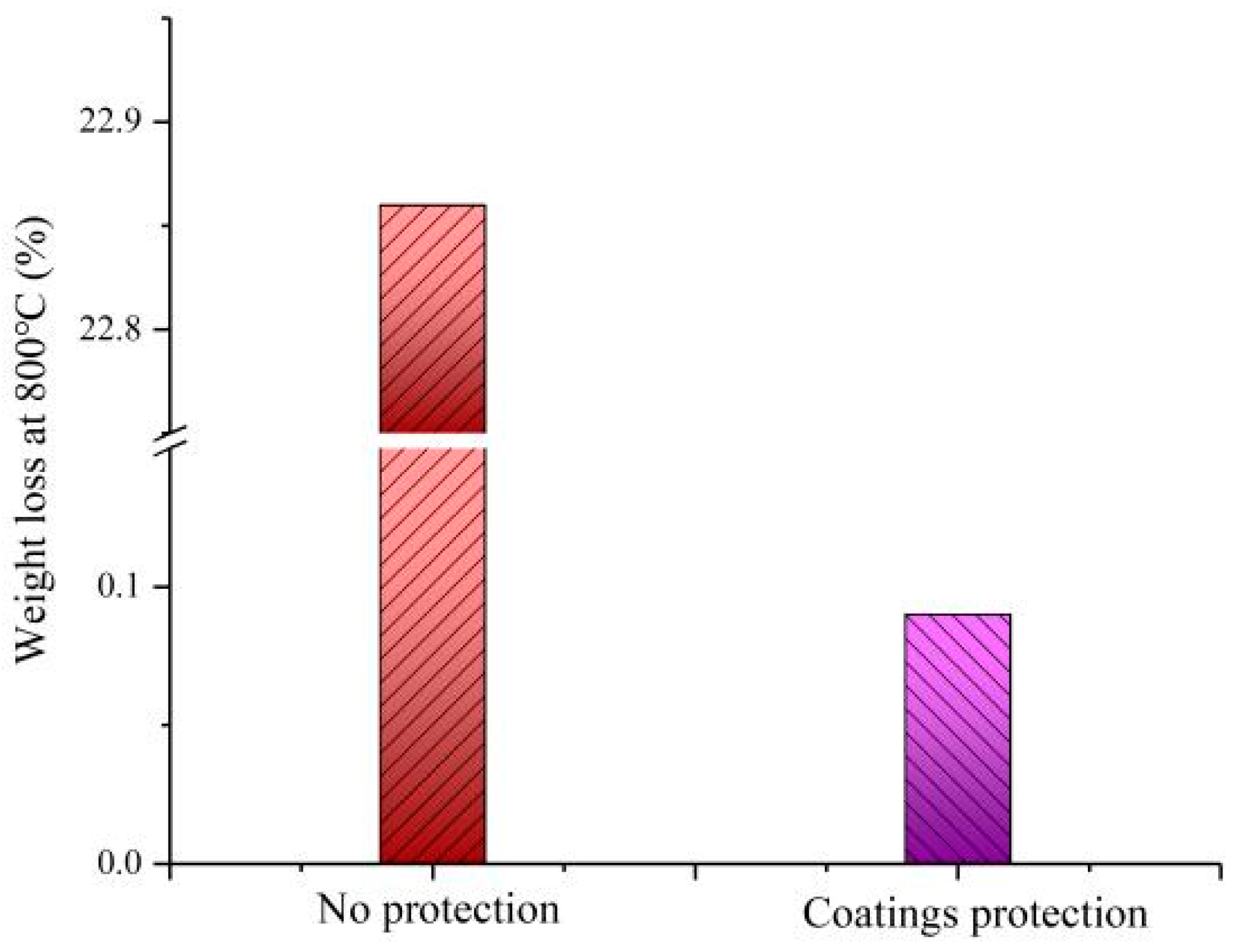
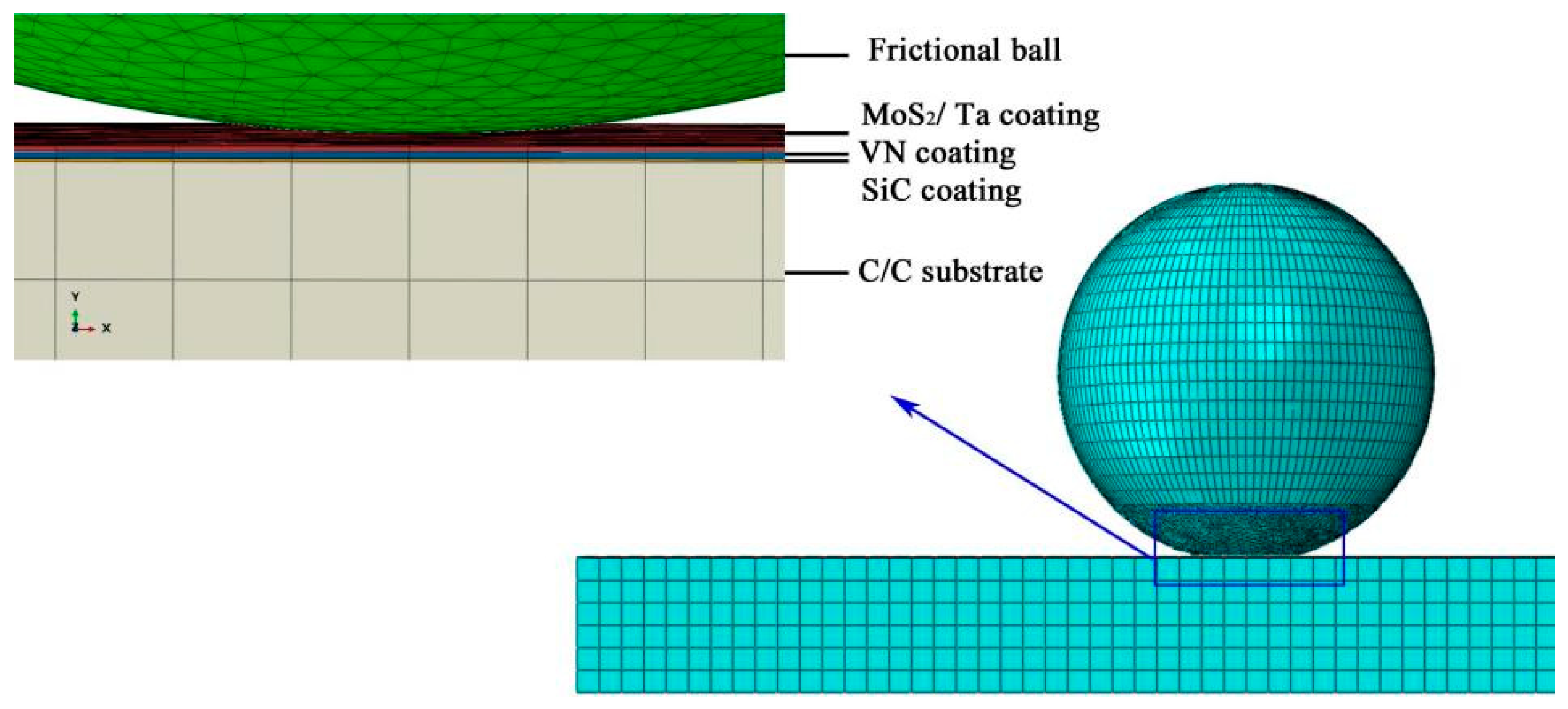

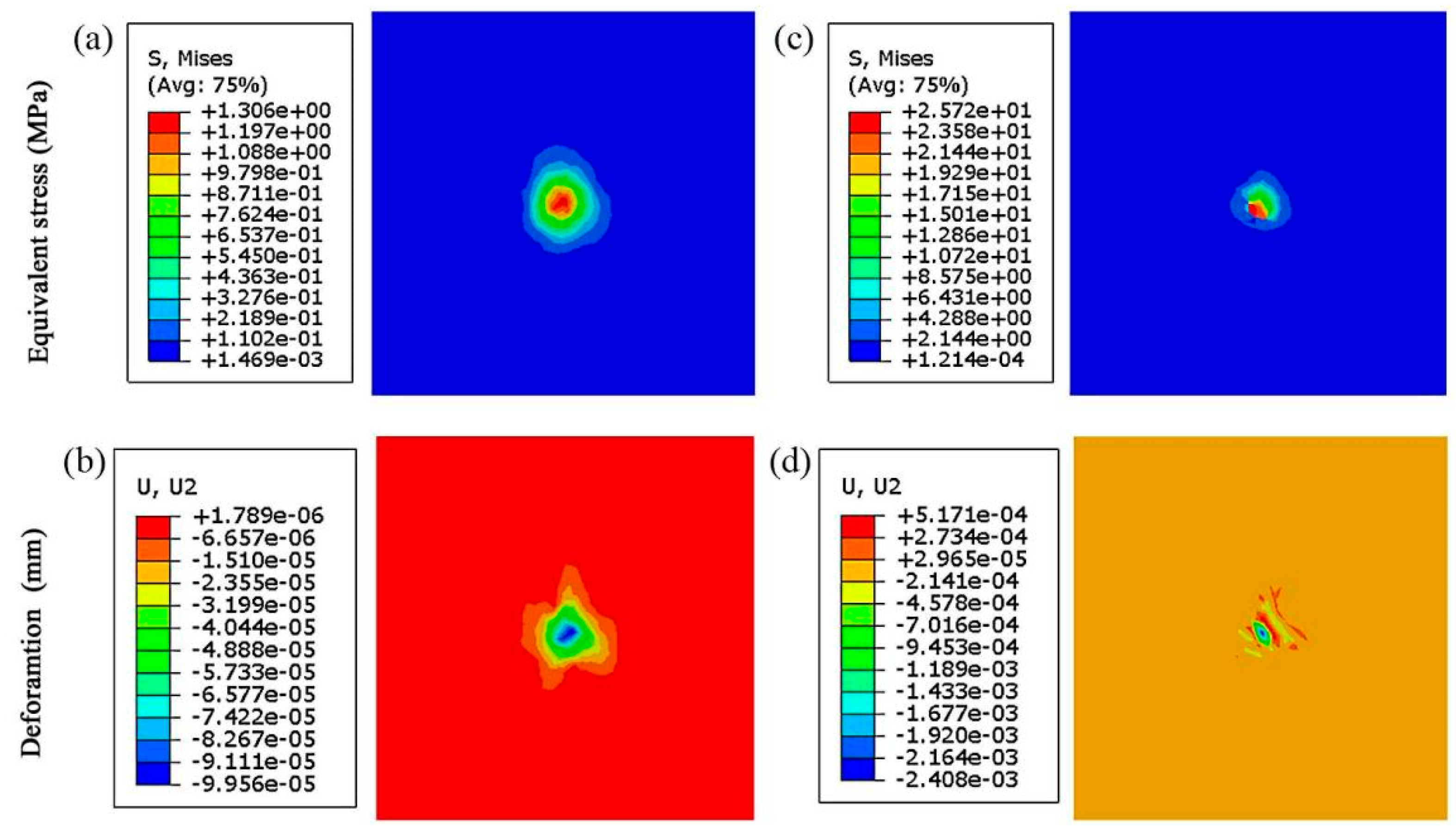
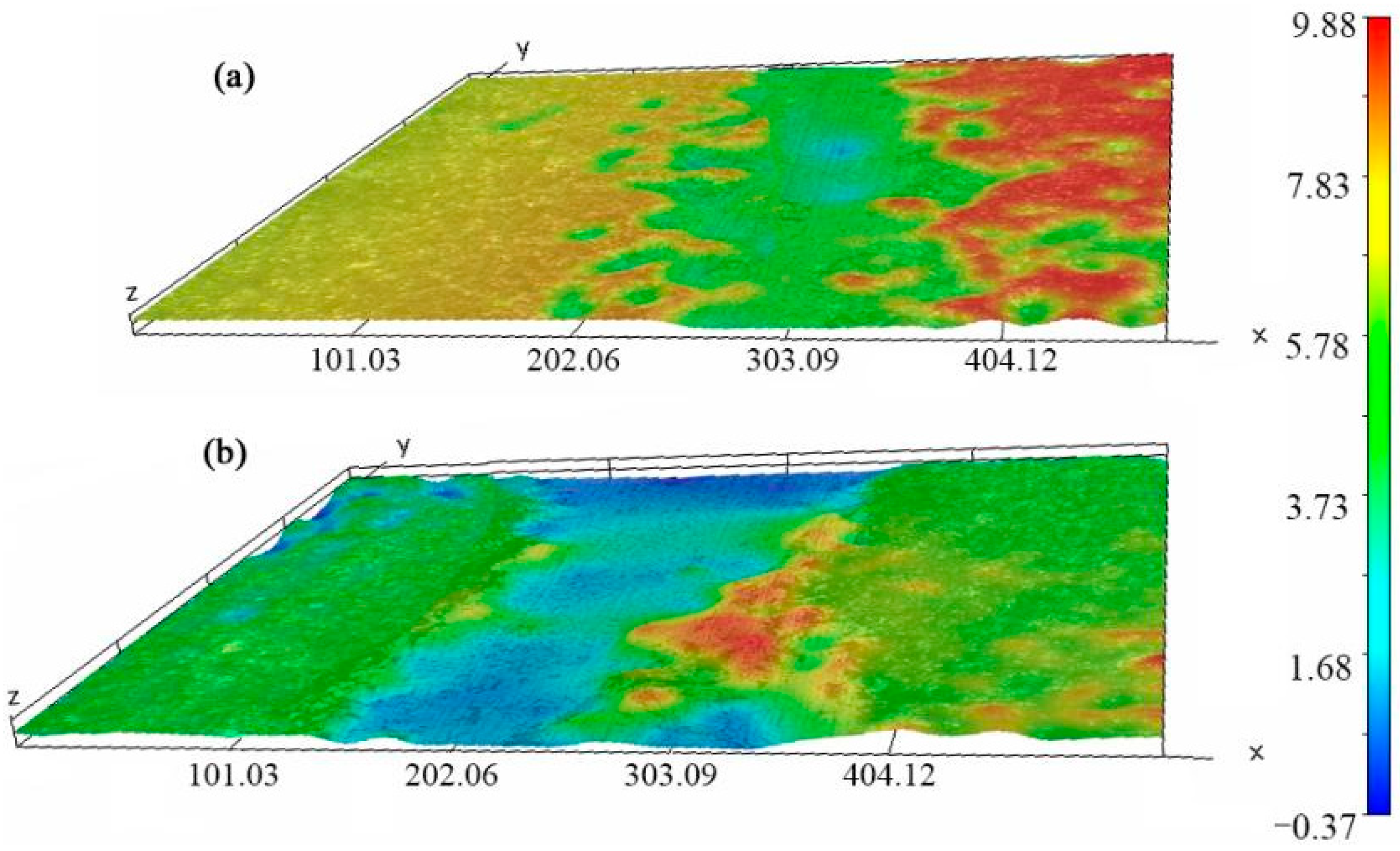
| Ar | H2 | Spraying Distance | Powder Feed Rate | Spraying Power |
|---|---|---|---|---|
| 12 slpm | 10 slpm | 100 mm | 15 g/min | 38 KW |
| Work Condition | Frictional Distance | Contact Load | Sliding Velocity | Time | Temperature |
|---|---|---|---|---|---|
| mm | N | mm/s | min | °C | |
| Dry sliding wear | 5 | 5 | 20 | 30 | 25/800 |
| Mechanical Property | SiC | VN | MoS2/Ta | C/C | Ball |
|---|---|---|---|---|---|
| Modulus of elasticity (GPa) | 410 | 178 | 27.57 | 21 | 211 |
| Poisson’s ratio | 0.14 | 0.29 | 0.37 | 0.25 | 0.30 |
| Density (kg/m3) | 3100 | 6130 | 4560 | 1910 | 7850 |
Publisher’s Note: MDPI stays neutral with regard to jurisdictional claims in published maps and institutional affiliations. |
© 2021 by the authors. Licensee MDPI, Basel, Switzerland. This article is an open access article distributed under the terms and conditions of the Creative Commons Attribution (CC BY) license (https://creativecommons.org/licenses/by/4.0/).
Share and Cite
Cao, J.; Chen, J.; Wang, X.; Wen, J. Tribology and Anti-Ablation Properties of SiC-VN-MoS2/Ta Composite Coatings on Carbon/Carbon Composites from 25 to 800 °C. Materials 2021, 14, 6772. https://doi.org/10.3390/ma14226772
Cao J, Chen J, Wang X, Wen J. Tribology and Anti-Ablation Properties of SiC-VN-MoS2/Ta Composite Coatings on Carbon/Carbon Composites from 25 to 800 °C. Materials. 2021; 14(22):6772. https://doi.org/10.3390/ma14226772
Chicago/Turabian StyleCao, Jun, Jianbin Chen, Xinbo Wang, and Jingbo Wen. 2021. "Tribology and Anti-Ablation Properties of SiC-VN-MoS2/Ta Composite Coatings on Carbon/Carbon Composites from 25 to 800 °C" Materials 14, no. 22: 6772. https://doi.org/10.3390/ma14226772






